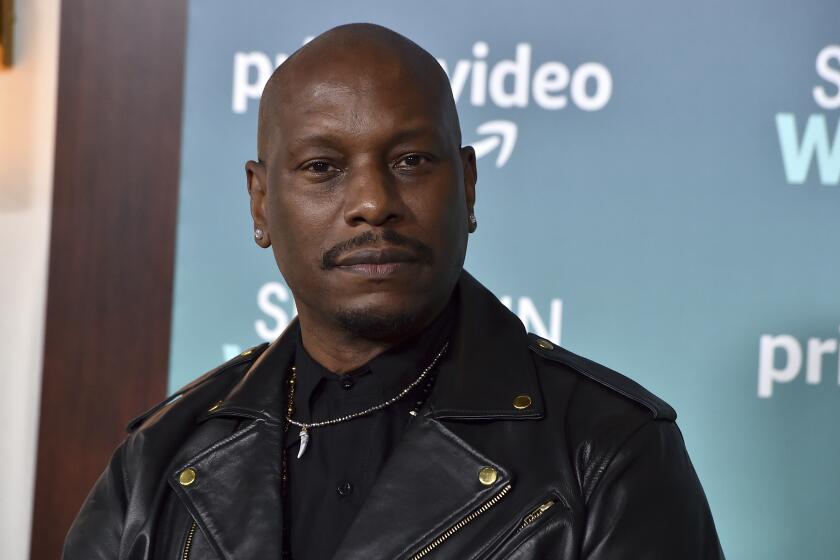MOVIE REVIEW : Decay, Joy in ‘A Rage in Harlem’
It is a world where the blind can see and women are men, where the body count is always in double figures and the double cross takes no one by surprise. It is a sensual, surreal, cartoonishly violent and breathtakingly bawdy comic universe, more upside down and inside out than Alice’s Wonderland. But in the novels of Chester Himes, the ambience of this anarchic fairy tale is black not white, and now, in “A Rage in Harlem,” it comes to us in an especially exuberant and entertaining package.
Himes’ Harlem novels have been tapped by Hollywood before, in the early 1970s, when Godfrey Cambridge and Raymond St. Jacques starred in “Cotton Comes to Harlem” and “Come Back Charleston Blue,” updated versions of Himes’ lethal pair of been-around detectives, Coffin Ed Johnson and Grave Digger Jones. Diverting though they were, those films didn’t really attempt to come to terms with the scathing, scabrous ambience that Himes’ characters called their own. This time around, director Bill Duke, screenwriters John Toles-Bey and Bobby Crawford and a potent cast that includes Forest Whitaker and Robin Givens have cut a lot closer to the bone.
“Harlem” (citywide) begins not in Harlem but in Natchez, Miss., on a dark and nasty night in 1956. A black gunman named Slim (an effortlessly charismatic Bajda Djola) and his gang are attempting to fence a trunkful of stolen gold, but when the fence attempts a double cross, Slim’s girlfriend Imabelle (Givens) double-crosses both of them, escaping to Harlem with the loot and the determination to unload it on Harlem numbers king Easy Money (Danny Glover).
Shoehorned into the tightest dresses the law allows, Givens’ Imabelle can’t help but draw double-entendre remarks and eye-popping stares from everyone from law-abiding luggage handlers to lascivious lady desk clerks. Imabelle’s erotic appeal is the engine that drives this particular machine (Himes’ original title for the novel was “For Love of Imabelle”), and Givens, sensing the potential here to escape forever from thralldom to the ghost of Tyson past, has taken hold of the part with both hands, giving a lusty, controlled performance without which the film’s potential could never have been realized.
Arriving in Harlem on the night of the annual Undertaker’s Ball (which features a vintage performance by Screamin’ Jay Hawkins), Imabelle hooks up with the unlikeliest man in the place, mild-mannered undertaker’s accountant and original timid soul Jackson. As played by the very accomplished Forest Whitaker, an actor who almost never makes a false move, Jackson is a bumbling, fumbling blob who says his prayers first thing in the morning and hangs his mother’s picture next to the Savior’s in the place of honor above his bed. He is the perfect comic foil for Imabelle’s sexiest-woman-in-12-states routine, and soon they are carrying on to such an extent that Jackson’s landlady grumbles (in a line that is pure Himes), “If Christ knew what kind of Christians he got here in Harlem, he’d climb back up on the cross and start over.”
Before the lovebirds can truly get to know each other, however, a very angry Slim and Co. turn up in Harlem, looking for both Imabelle and all that gold. Jackson, out of his depth and desperately in love, turns in despair to his estranged half-brother and full-time con man Goldy (Gregory Hines) and Goldy’s pal, the transvestite madam Big Kathy (the very fine South African actor Zakes Mokae). Goldy wants the gold, Jackson the girl, and the commotion they set in motion alerts Harlem cops Coffin Ed and Grave Digger, who just want to put as many people behind bars as possible.
Obviously, much of “A Rage in Harlem” (rated R for violence, sensuality, language) is traditional hard-boiled material. What is different here, as in the novels, is Himes’ Harlem milieu. This is an exuberant, hopeless world, rarely glimpsed by outsiders, where death and laughter are twins, a world that takes in law-abiding, church-going families, community institutions such as the H. Exodus Clay Funeral Parlor as well as places like Big Kathy’s bordello, home of what has to be the hottest dance routines in town.
Director Duke, also an accomplished actor, makes his feature directing debut in “A Rage in Harlem,” but he brings with him a considerable amount of TV directing experience, as well as an obvious affinity for the material. He clearly sees in Himes what Himes saw in Harlem: a raw but bracing locale in which to work, bursting with life and sadness, joyously bitter as well as unabashedly sensual.
Himes’ vision was so strong, in fact, that Hollywood still apparently isn’t ready for it; this version of “A Rage in Harlem,” having toned down a lot of the novel’s surreal violence and more outre wall-to-wall-drug-fiend specifics, is considerably milder than Himes’ creation. Yet, more important, Duke and company have been true to Himes’ brash, blaspheming spirit, and that is no small thing.
‘A Rage in Harlem’
Forest Whitaker: Jackson
Gregory Hines: Goldy
Robin Givens: Imabelle
Zakes Mokae: Big Kathy
Danny Glover: Easy Money
Bajda Djola: Slim
A Palace presentation of a Palace Wooley/Boyle Production, released by Miramax Films. Director Bill Duke. Producers Stephen Wooley, Kerry Boyle. Executive producers Nik Powell, William Horberg, Terry Glinwood. Screenplay John Toles-Bey, Bobby Crawford, based on the novel by Chester Himes. Cinematographer Toyomichi Kurita. Editor Curtis Clayton. Costumes Nile Samples. Music Elmer Bernstein. Production design Steven Legler. Sound Paul Cole. Running time: 1 hour, 50 minutes.
MPAA-rated R (violence, sensuality, language).
More to Read
Only good movies
Get the Indie Focus newsletter, Mark Olsen's weekly guide to the world of cinema.
You may occasionally receive promotional content from the Los Angeles Times.











